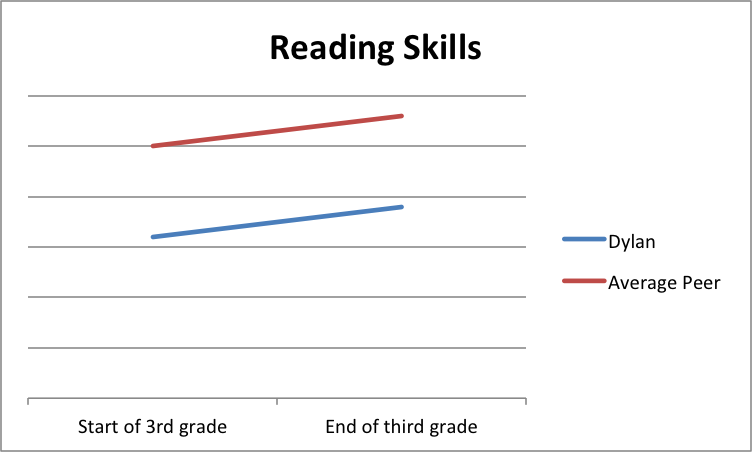Progress vs. Meaningful Progress: Why Knowing the Difference Makes All the Difference
Your child (we'll call him Dylan) has special needs. For example, let's say he has dyslexia. At the beginning of the third grade, Dylan was reading at an early kindergarten level. Now, at the end of the third grade, he’s reading at a late kindergarten level.
Q: Did Dylan make progress in his reading?
A: Depends how you measure “progress.”
Measuring Progress, Comparing Trajectories
Did Dylan’s reading level increase? You bet. His gains in reading are nice to see, and Dylan, his parents, and his teacher should be proud of him for the hard work he probably did to improve his reading. Here is a visual representation of Dylan’s reading skills at the beginning and end of the third grade.
But did he make progress?
To answer this question, we need to compare Dylan’s performance to the performance of his same-age peers at the beginning and the end of the third grade, using nationally-standardized, norm-referenced assessments. That is, we need to compare trajectories. Here’s a visual representation of what I mean.
When you compare Dylan’s reading development with the development of his peers, he did not make significant gains, or “meaningful progress.” Although his reading level improved, he is not "catching up" to his peers.
What does meaningful progress look like?
When assessing the effectiveness of an intervention over a period of time, say Orton-Gillingham for dyslexia administered twice per week at thirty minutes per session, a truly effective intervention will lead to changes in a child’s trajectory compared with that of his typically-developing peers who did not receive the intervention. That is, your child will start catching up to his peers, like in the figure below.
"So, What's the Problem, Doc?"
If you are a parent, teacher, or school administrator of children with special needs, understanding the difference between progress and meaningful progress is of upmost importance.
Too often in Individualized Education Program (IEP) meetings do I hear team members stating that the student has made progress in an area of weakness (say, reading) due to an intervention (say, resource center), and they follow that statement with data showing Dylan’s higher Fountas & Pinnell level.[1]
The problem is that simply comparing new Dylan to old Dylan gives you an inaccurate picture of your child, which could mislead the direction of his care. As you now know, we must compare Dylan’s trajectory to that of his peers to measure meaningful progress - and to set him up for success.
Being an Informed and Empowered Parent
To ensure that your child is getting the services he needs, here's what you can do:
Evaluate. Objective testing is needed before and after an intervention to measure progress accurately. If you learn that your child is not making real gains, then you can re-evaluate your options: Should your child continue with the same intervention and then re-assess later? Should you increase the dosage (frequency and/or intensity) of the intervention? Should you try something different? Without objective testing, however, you may be working under the false assumption that your child is doing better than he is, which could lead to maintaining the status quo or, worse, removing needed interventions.
Communicate. Talk with your child's teachers and service providers. When your child's "progress" comes up, make sure you are on the same page.
Educate and Advocate. For parents preparing for IEP meetings, be ready for a discussion about your child’s progress, as “progress” is the legal benchmark for determining the need for special education services. When you hear the word “progress,” ask for a definition of the term and data to support any claims. It is your right as a parent to challenge both.
[1] The Fountas & Pinnell Benchmark Assessment System, although found to be a reliable and valid measure for assessing students’ reading levels, is not a norm-referenced assessment and, thus, should not be used to quantify a student’s reading skills and compare them to others’ skills.



